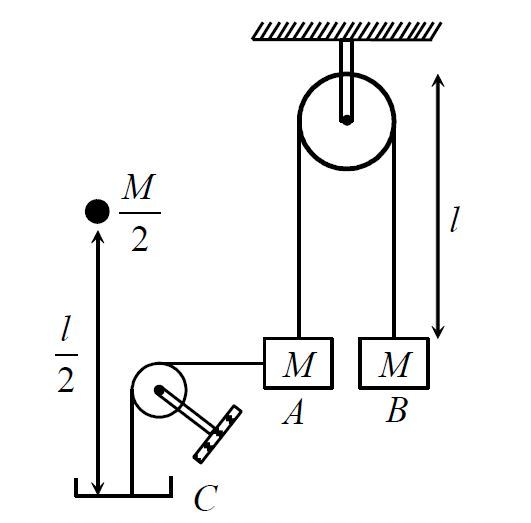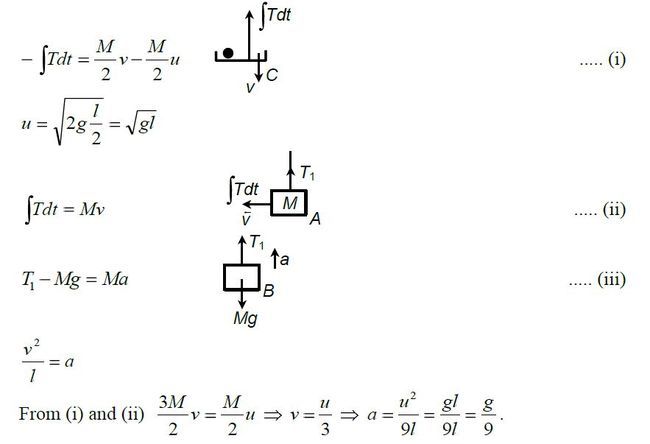Please Help!
Two blocks and of same mass are connected with each other with an ideal string of length passing over an ideal pulley. The block is connected to a light pan with an ideal string as shown in figure. A particle of mass is dropped on pan from height as shown. If collision between particle and pan is plastic, acceleration of just after the collision is?

Ans is .

Is this solution correct?
No vote yet
1 vote
Easy Math Editor
This discussion board is a place to discuss our Daily Challenges and the math and science related to those challenges. Explanations are more than just a solution — they should explain the steps and thinking strategies that you used to obtain the solution. Comments should further the discussion of math and science.
When posting on Brilliant:
*italics*or_italics_**bold**or__bold__paragraph 1
paragraph 2
[example link](https://brilliant.org)> This is a quote# I indented these lines # 4 spaces, and now they show # up as a code block. print "hello world"\(...\)or\[...\]to ensure proper formatting.2 \times 32^{34}a_{i-1}\frac{2}{3}\sqrt{2}\sum_{i=1}^3\sin \theta\boxed{123}Comments
@Raghav Vaidyanathan @Tanishq Varshney @Kushal Patankar Help!
Log in to reply
@satvik pandey i have made a note on this problem inviting views of other brilliant members(bc now even i am confused :/ )
Log in to reply
Thanks for making it! :)
Why wasn't T1 impulsive.😓
Can you please post the solution to Angular width of Refracted Beam!
Raghav Vaidyanathan
Log in to reply
@Raghav Vaidyanathan
Log in to reply
ok
Log in to reply
Could you please explain this answer?
@Nishant Rai
Although your answer is correct, the FBDs that you have drawn are not. You have missed out the gravitational force on A. Due to this reason, you have skipped using T1−Mg=Ma
In reality, at the moment the mass strikes the pan:
T1=Mg+Mlv2
And hence: T1−Mg=Ma=Mlv2
Otherwise, you can also use constraint relations to get to same result.
Log in to reply
@satvik pandey
Raghav Vaidyanathan
i have done the same thing, (this solution is not mine, this question came in mock paper of some coaching institute, they have provided this solution)
Log in to reply
Okay, but they aren't fully wrong, we can get everything without FBD itself...
Log in to reply
btw you are appearing for JEE ? are you enrolled in any coaching institute?
Log in to reply
Yes, FIITJEE
I have a confusion. I think it is assumed that just after the collision block A performs a circular motion. But as soon as the block a A gets a tangential velocity it would have centripetal as well as a radial acceleration. How can we ignore that?
I think you guys would like to see this discussion.
My Answer is a little different..